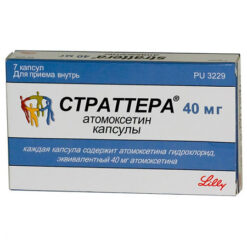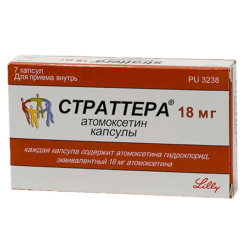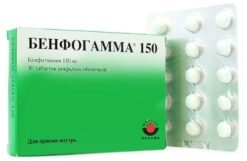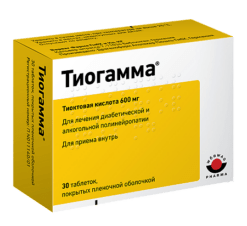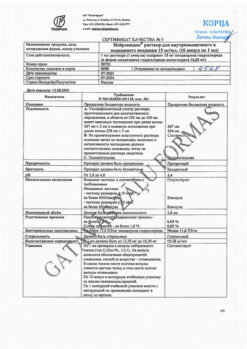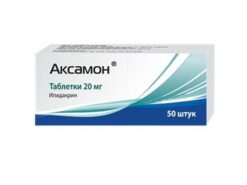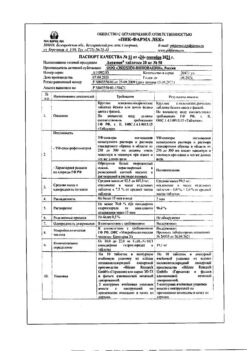Subtotal: €40.39
Stimuloton, 50 mg 30 pcs
€1.00
Out of stock
(E-mail when Stock is available)
Pharmacodynamics
An antidepressant. Selective serotonin reuptake inhibitor. It has a weak effect on norepinephrine and dopamine reuptake. In therapeutic doses, sertraline also inhibits serotonin uptake by human platelets.
The drug does not have stimulant, sedative or anticholinergic effects. The drug does not interact with m-choline, serotonin, dopamine, histamine, adreno-, GABA- and benzodiazepine receptors.
When using Stimuloton there is no increase in body weight. The drug does not cause mental or physical addiction.
The antidepressant effect is noted by the end of the second week of regular use of the drug, whereas the maximum effect is reached only after 6 weeks.
Pharmacokinetics
Absorption
Absorbed from the gastrointestinal tract slowly but almost completely. C max is reached 4.5-8.4 h after oral administration. When the drug is taken simultaneously with meals its bioavailability is increased by 25%, C max is reached faster.
Distribution
When the drug is taken once daily, C ss is usually reached after one week. It is 98% bound to plasma proteins. V d is greater than 20 L/kg. Sertraline is excreted with breast milk. There is no data on its ability to penetrate the placental barrier.
Metabolism
Sertraline is biotransformed on first passage through the liver, undergoing N-demethylation. Its main metabolite, N-desmethylsertraline, is less active than sertraline.
0.2% of sertraline is excreted unchanged in the urine, the remainder as metabolites with the urine and feces in equal amounts. T 1/2 is 22-36 h and is independent of the age and sex of patients. T 1/2 N-desmethylsertraline is 62-104 h. Sertraline is not excreted by hemodialysis. Pharmacokinetics in special clinical cases T1/2 and AUC of Sertraline are increased in liver dysfunction. Regardless of the severity of renal impairment, the pharmacokinetics of sertraline are not altered by its continued use.
Indications
• Major depressive episodes. Prevention of major depressive episodes. Obsessive-compulsive disorder (OCD) in adults and children over 6 years of age.
• Panic disorders with and without agoraphobia.
• Post-traumatic stress disorder (PTSD).
• Social phobia.
Pharmacological effect
Pharmacotherapeutic group: antidepressant.
ATX code: N06A B06
Pharmacological properties
Pharmacodynamics
Mechanism of action
Sertraline is an antidepressant, a powerful selective serotonin (5-HT) reuptake inhibitor (SSRI). It has a very weak effect on the reuptake of norepinephrine and dopamine. When used in therapeutic doses, sertraline blocks the reuptake of serotonin in human platelets. In controlled clinical studies, no stimulant, sedative or anticholinergic effects were observed, and no impairment of psychomotor functions was observed in volunteers. Sertraline does not cause drug dependence and does not cause weight gain with long-term use.
Animal models have shown that, due to the selective inhibition of 5-HT uptake, sertraline does not enhance catecholamine activity, has no affinity for muscarinic (cholinergic), serotonergic, dopaminergic, adrenergic, histaminergic, gamma-aminobutyric acid (GABA) or benzodiazepine receptors. In animal models, sertraline was also shown to be noncardiotoxic. Long-term use in animals has been associated with the negative feedback regulation of norepinephrine receptors in the brain, which is characteristic of other antidepressants and anti-obsessive drugs.
Sertraline does not lead to drug abuse. In a placebo-controlled, double-blind comparative study examining the abuse potential of sertraline, alprazolam, and dextroamphetamine, no abuse potential was observed for sertraline. In contrast to this observation, patients receiving alprazolam and dextramphetamine showed a greater tendency to develop drug abuse compared with placebo. Abuse potential was based on measures of the drug’s ability to induce positive emotions, euphoria, and abuse. In rhesus monkeys trained to self-administer cocaine, sertraline did not act as a rewarding stimulus, unlike phenobarbital and dextramphetamine.
Pharmacokinetics
Absorption
The maximum concentration of the drug in the blood plasma (Cmax) and the area under the pharmacokinetic concentration-time curve (AUC) are proportional to the dose in the range of 50-200 mg, while the linear nature of the pharmacokinetic dependence is revealed. When using sertraline in a dose of 50 mg to 200 mg once a day for 14 days, the concentration of sertraline in the blood plasma reached Cmax 4.5-8.4 hours after administration. Absorption is high, at a slow rate. During food intake, bioavailability changes slightly (by 25%).
Distribution
Approximately 98% of sertraline is bound to plasma proteins.
Metabolism
Sertraline undergoes active biotransformation during its first passage through the liver. The main metabolic pathway is N-demethylation. The main metabolite found in plasma, N-desmethylsertraline, is significantly less active (approximately 20-fold) than sertraline in vitro and is virtually inactive in in vivo models of depression. The half-life (T½) of N-desmethylsertraline ranges from 62 to 104 hours. Both sertraline and N-desmethylsertraline undergo oxidative deamination and subsequent reduction, hydroxylation and glucuronidation. When labeled sertraline was administered to healthy volunteers, less than 5% radioactive sertraline was observed in the blood plasma. About 40 – 45% of the administered dose was found in the urine after nine days. Unchanged sertraline is not excreted through the kidneys. Over the same period, approximately 40 – 45% of administered sertraline was recovered in feces, including 12 – 14% unchanged sertraline.
AUC (0-24 h), Cmax and Cmin of desmethylsertraline increases depending on the dose and time by approximately 5 – 9 times from the 1st day to the 14th.
Removal
The average T½ of sertraline in young and elderly patients is 22-36 hours. According to the final T½, an approximately two-fold accumulation of the drug is observed until the onset of equilibrium concentrations after 1 week of treatment (dose once a day). T1/2 of N-desmethylsertraline varies within 62-104 hours. Sertraline and N-desmethylsertraline are actively biotransformed; the resulting metabolites are excreted in equal quantities by the kidneys and through the intestines. Unchanged sertraline is excreted by the kidneys in small amounts (<0.2%). The pharmacokinetic profile in adolescents and the elderly does not differ from that in patients aged 18 to 65 years.
Special patient groups
Use in children
The pharmacokinetics of sertraline in children with obsessive-compulsive disorder (OCD) have been shown to be similar to those in adults (although sertraline metabolism is slightly more active in children). However, given the lower body weight in children (especially aged 6-12 years), the drug is recommended to be used in a lower dose to avoid excessive concentrations of sertraline in the blood plasma (see section Dosage and Administration).
Adolescents and elderly patients
The pharmacokinetic profile in adolescents and the elderly does not differ from the pharmacokinetic profile in patients aged 18 to 65 years.
Use for liver failure
With repeated administration of sertraline in patients with mild liver cirrhosis, an increase in T1/2 of the drug and an almost threefold increase in AUC and Cmax are observed compared with those in healthy people. There were no significant differences in binding to plasma proteins in the two groups. When using sertraline in patients with impaired liver function, it is necessary to discuss the advisability of reducing the dose or increasing the interval between taking the drug.
Use for renal failure
Sertraline undergoes active biotransformation, so it is excreted unchanged by the kidneys in small quantities. In patients with mild and moderate renal failure (creatinine clearance (CR) 30-60 ml/min) and patients with moderate or severe renal failure (CR 10-29 ml/min), the pharmacokinetic parameters (AUC0-24 and Cmax) of sertraline when taken repeatedly did not differ significantly from the control group. In all groups, T1/2 of sertraline was the same, and there were no differences in binding to plasma proteins. It was found that, as expected, given the insignificant renal excretion of sertraline, no dose adjustment is required depending on the severity of renal failure.
Special instructions
Sertraline should not be co-administered with MAOIs, within 14 days before starting MAOIs and for 14 days after their discontinuation.
Blood concentrations of tricyclic antidepressants should be monitored to assess the need for dose adjustment.
When using sertraline and tolbutamide simultaneously, it is necessary to monitor the concentration of blood glucose (see section Interaction with other drugs).
Serotonin syndrome (SS)
Cases of the development of SS and NMS have been described with the use of SSRIs. The risk of these complications increases with simultaneous use of SSRIs with other serotonergic drugs (including amphetamines, triptans and fentanyl and their analogs, tramadol, dexomethorphan, tapentadol, meperedine, methadone, pentazocine), as well as drugs that affect the metabolism of serotonin (including monoamine oxidase inhibitors), antipsychotics and others dopamine receptor antagonists. Manifestations of SS may include changes in mental status (in particular, agitation, hallucinations, coma), autonomic lability (tachycardia, blood pressure fluctuations, hyperthermia), changes in neuromuscular transmission (hyperreflexia, impaired motor coordination) and/or gastrointestinal disorders (nausea, vomiting and diarrhea). Some manifestations of SS, including hyperthermia, muscle rigidity, autonomic lability with possible rapid fluctuations in vital signs, as well as changes in mental status, may resemble symptoms that develop in NMS. It is necessary to monitor patients for the development of clinical manifestations of SS and NMS.
QTc prolongation or torsade de pointes (TdP)
During post-marketing use of sertraline, cases of prolongation of the QTc interval on the ECG and the development of TdP arrhythmia have been reported. Most cases were observed in patients with risk factors for developing such conditions. Therefore, caution should be exercised when using sertraline in patients with risk factors for prolongation of the QTc interval on the ECG or the development of TdP arrhythmia (see Interactions with Other Drugs).
Switching from other SSRIs, antidepressants or anti-obsessive medications
The required interval between stopping one SSRI and starting another similar drug has not been established. Caution should be exercised when switching to sertraline from other SSRIs, antidepressants or anti-obsessive medications, especially from long-acting medications such as fluoxetine.
When replacing one neuronal serotonin uptake inhibitor with another, there is no need for a washout period. However, caution is required when changing the course of treatment.
Other serotonergic drugs, such as tryptophan, fenfluramine and 5-HT agonists
The simultaneous use of sertraline with other drugs with a pronounced effect on neurotransmitter transmission (such as amphetamines, tryptophan, fenfluramine, 5-HT agonists or herbal medicines, St. John’s wort) should be used with caution and, if possible, avoided, given the potential pharmacodynamic interaction.
Suicidal behavior
Depression is associated with an increased risk of suicidal ideation, self-harm, and suicide.
This risk persists until stable remission. Given that the patient’s condition may not improve in the first few weeks of therapy or longer, patients should be closely monitored until such improvement occurs. It is also common for the risk of suicide to increase during the early stages of recovery. Other medical conditions for which sertraline may be prescribed may also be associated with an increased risk of suicidal events. In addition, these diseases may accompany major depressive disorder. In this regard, the same precautions should be taken as when treating major depressive disorder. Patients with a history of suicidal tendencies or patients prone to suicidal ideation before starting therapy have a higher risk of suicidal thoughts or suicide attempts. Such patients should also be under close medical supervision during therapy.
All patients, especially those at risk, receiving sertraline therapy should be carefully monitored to detect the development or worsening of symptoms of suicidal behavior. Patients, their relatives and guardians should be warned of the need to monitor the condition for the emergence or worsening of depression, the emergence of suicidal thoughts or behavior, as well as for any changes in behavior, especially at the beginning of therapy and with any change in the dose of the drug. The risk of suicide attempts should also be kept in mind, especially in patients with depression. In this regard, in order to reduce the risk of overdose, it is necessary to take the minimum dose of the drug that provides a sufficient therapeutic effect.
Patients with depression and other mental disorders are at risk of suicidal behavior. These diseases themselves are strong predisposing factors for such behavior. In children, adolescents and young adults (ages 18–24 years) with depression or other mental disorders, antidepressants (SSRIs and others) have been found to increase the risk of suicidal ideation and behavior compared with placebo. Therefore, when using sertraline or any other antidepressants in children, adolescents and young adults (under 24 years of age), the risk of suicide should be weighed against the benefits of their use. In addition, there was no increase in the risk of suicidal behavior in adult patients over 24 years of age, and a decrease in this risk was noted in patients aged 65 years and older.
Use in children and adolescents under 18 years of age
Sertraline should not be used to treat children and adolescents under the age of 18 years, with the exception of patients with OCD aged 6-17 years. Suicidality (suicide attempts or suicidal thoughts) and hostility (primarily aggressiveness, oppositional behavior and anger) were observed more often in patients receiving antidepressant therapy than in patients receiving placebo. If a decision is made to proceed with therapy based on the clinical assessment of the patient, the patient should be carefully monitored for symptoms of suicidal behavior. In addition, it should be borne in mind that data on the effect of the drug on growth, puberty and cognitive and behavioral development of the child are limited.
During long-term therapy of pediatric patients, clinicians should monitor for abnormal developmental abnormalities.
Withdrawal syndrome
When stopping a drug, withdrawal symptoms often occur, especially if the drug is stopped abruptly. Withdrawal symptoms were observed in 23% of patients who stopped taking sertraline and in 12% of patients who continued taking the drug.
The risk of these symptoms depends on several factors, including the duration of therapy and dosage, and the rate of dose reduction. The most common reactions are dizziness, sensory disturbances (including paresthesia), sleep disturbances (including insomnia and deep sleep), agitation or anxiety, nausea and/or vomiting, tremor and headache. These symptoms are usually mild to moderate in severity; however, in some cases they can be severe. Typically, these symptoms occur during the first few days of discontinuation of therapy, but there are very rare reports of the development of such symptoms in patients who inadvertently missed a dose. Typically these symptoms do not get worse and resolve within two weeks, except in some cases where they may last longer (2-3 months or more). In this regard, it is recommended to discontinue the drug gradually, reducing the dose over several weeks or months, depending on the patient’s condition.
Akathisia/psychomotor agitation
Sertraline use may be associated with the development of akathisia, characterized by a subjective feeling of discomfort or restlessness and a need to move, accompanied by an inability to sit or stand still. Most often, such symptoms are observed in the first weeks of treatment. Increasing the dose in these patients may be harmful.
Liver dysfunction
If it is necessary to use sertraline in patients with impaired liver function, consider reducing the dose of the drug or the frequency of administration. Sertraline should not be taken in patients with severe hepatic impairment.
Renal dysfunction
It was found that, as expected, given the insignificant renal excretion of sertraline, no dose adjustment is required depending on the severity of renal failure.
Electroconvulsive therapy
The possible success or risk of this combination treatment has not been studied (clinical data are not available).
Convulsions
There is no experience with the use of sertraline in patients with seizure disorders, so its use should be avoided in patients with unstable epilepsy, and patients with controlled epilepsy should be carefully monitored during treatment. If seizures occur, the drug should be discontinued.
Activation of mania/hypomania
During clinical studies prior to the marketing of sertraline, hypomania and mania were observed in approximately 0.4% of patients receiving sertraline. Cases of activation of mania/hypomania have also been described in a small proportion of patients with manic-depressive psychosis who received other antidepressant or antiobsessive drugs. Sertraline should be used with caution in patients with a history of mania or hypomania. Close medical supervision is necessary and sertraline should be discontinued if the patient exhibits any signs of mania.
Schizophrenia
Patients with schizophrenia may experience exacerbation of psychotic symptoms.
Pathological bleeding/hemorrhage
There have been reports of bleeding or hemorrhage ranging from ecchymosis and purpura to life-threatening bleeding/hemorrhage with the use of SSRIs. Caution should be exercised when prescribing SSRIs in combination with drugs that have an established ability to affect platelet function (for example, atypical antipsychotics and phenothiazines, most tricyclic antidepressants, acetylsalicylic acid and NSAIDs), as well as in patients with a history of hemorrhagic diseases.
In addition, when using sertraline with indirect anticoagulants, it is recommended to monitor the PT at the beginning of treatment with sertraline and after its discontinuation.
Hyponatremia
Transient hyponatremia occurs more often in older patients, in patients with dehydration, or when taking diuretics. This side effect is associated with the syndrome of inappropriate secretion of antidiuretic hormone.
Cases of decreased plasma sodium concentrations below 110 mmol/L have been reported. If symptomatic hyponatremia develops, sertraline should be discontinued and adequate therapy aimed at correcting the concentration of sodium in the blood should be prescribed. Signs and symptoms of hyponatremia include headache, difficulty concentrating, memory loss, weakness and unsteadiness, which can lead to falls. In more severe cases, hallucinations, fainting, seizures, coma, respiratory arrest, and death may occur.
Due to the fact that there is a clear relationship between the development of depression and OCD, depression and panic disorders, depression and PTSD, depression and social phobia, the same precautions should be taken when treating patients with OCD, panic disorders, PTSD and social phobia as when treating depression.
Fractures
Based on epidemiological studies, it has been established that the use of serotonin reuptake inhibitors, including sertraline, increases the risk of fractures. The mechanism leading to the increased risk is not completely clear.
Elderly patients
The profile of adverse reactions in elderly and young patients does not differ. In old age, the drug should be used with caution due to the increased risk of developing
hyponatremia.
Diabetes mellitus/impaired blood glucose control
Exacerbation of diabetes mellitus and/or impaired glucose control (hyperglycemia and hypoglycemia) have been reported with the use of SSRIs, including sertraline, in patients with or without diabetes mellitus. In this regard, glucose concentrations should be monitored.
Particular attention is required in patients with diabetes mellitus, as they may require dose adjustment of oral hypoglycemic agents and/or insulin.
Angle-closure glaucoma
SSRIs, including sertraline, affect pupil size, leading to mydriasis. In this case, a narrowing of the angle of the eye is observed, which leads to an increase in intraocular pressure and the development of angle-closure glaucoma, especially in patients with a predisposition. The drug should be used with caution in patients with angle-closure glaucoma or a history of glaucoma.
Laboratory methods
False-positive urine immunoassays for benzodiazepines have been reported in patients taking sertraline. This is due to the low specificity of screening tests. False-positive results may also occur for several days after discontinuation of sertraline therapy. Additional tests such as gas chromatography and mass spectrometry can help distinguish sertraline from benzodiazepines.
Grapefruit juice
The simultaneous use of sertraline and grapefruit juice is not recommended.
Sexual dysfunction
Drugs of the SSRI and SNRI group can cause sexual dysfunction (see section Side effects). There are reports of long-term sexual dysfunction, when symptoms did not disappear after discontinuation of SSRIs and SNRIs.
Sodium content
This medicine contains less than 1 mmol (23 mg) of sodium, which means it contains virtually no sodium.
Impact on the ability to drive vehicles and machinery
The use of sertraline, as a rule, is not accompanied by impairment of psychomotor functions. However, its use simultaneously with other drugs can lead to impairment of attention and coordination of movements.
Therefore, during treatment with sertraline, driving vehicles, special equipment or engaging in activities associated with increased risk is not recommended.
Active ingredient
Sertraline
Composition
Active ingredient: 50 mg or 100 mg of sertraline in 1 tablet (in the form of 55.95 mg and 111.90 mg of sertraline hydrochloride, respectively);
Excipients: magnesium stearate, hyprolose, sodium carboxymethyl starch (type A), calcium hydrogen phosphate dihydrate, microcrystalline cellulose; shell: macrogol 6000, titanium dioxide (C.I.77891 EEC 171), hypromellose.
Pregnancy
Pregnancy
There have been no controlled studies of the use of sertraline in pregnant women, so the drug should be used in this category of patients only if the expected benefit to the mother outweighs the potential risk to the fetus.
However, a significant body of data has found no evidence of induction of birth defects by sertraline. Animal studies have shown a possible effect of sertraline on reproductive function. This effect is likely due to maternal toxicity caused by the pharmacodynamic effects of sertraline on the fetus.
Some infants whose mothers took sertraline during pregnancy experienced symptoms similar to withdrawal reactions. This phenomenon was also observed when taking other SSRI antidepressants.
Women of reproductive age who are to be treated with sertraline should be advised to use effective contraception.
Breast-feeding
Sertraline and its metabolite N-desmethylsertraline are found in breast milk in small quantities. In general, small amounts of sertraline were found in the blood plasma of newborns, with the exception of one case where 50% of the concentration in maternal plasma was found in the blood plasma of the newborn (with no noticeable effect on the health of the newborn). Treatment with this drug during breastfeeding is not recommended. If treatment is still necessary, it is better to stop breastfeeding.
Infants whose mothers took sertraline and other SSRIs or SNRIs during pregnancy have experienced complications requiring additional hospitalization, respiratory support, and tube feeding. Newborns whose mothers took sertraline during late stages of pregnancy, especially in the third trimester, should be closely monitored. These newborns may present with the following symptoms: respiratory distress, cyanosis, apnea, seizures, temperature instability, feeding difficulties, vomiting, hypoglycemia, hypotonia, hypertonia, hyperreflexia, tremors, muscle twitching, irritability, lethargy, prolonged crying, somnolence and difficulty falling asleep. These symptoms may be due to direct serotonergic effects or may be drug withdrawal symptoms. In most cases, these complications begin immediately or shortly (< 24 hours) after birth. It should be borne in mind that in some cases the clinical picture may be similar to the symptoms of serotonergic syndrome.
Newborns whose mothers took SSRIs during pregnancy may also be at increased risk of developing persistent pulmonary hypertension of the newborn (PPHN). PPHN accounts for 5 cases per 1000 pregnancies and is one of the causes of morbidity and mortality in newborns. Several recent epidemiological studies suggest an association between SSRI use (including sertraline) and PPHN. Fertility
In one of two studies in mice, a decrease in fertility was noted with sertraline at a dose of 80 mg/kg (this is 4 times the maximum recommended dose for humans when calculated mg/m2).
According to the described clinical cases, taking some SSRIs has an effect on sperm quality, but this effect is reversible.
Contraindications
known hypersensitivity to sertraline and other components of the drug;
children under 6 years of age (with OCD); for other indications, the drug is contraindicated in patients under 18 years of age;
The use of sertraline with irreversible monoamine oxidase inhibitors (MAOIs) is contraindicated due to the risk of developing serotonin syndrome (SS), manifested by agitation, tremor and hyperthermia. Sertraline should not be started within 14 days after discontinuation of irreversible MAOIs, and sertraline therapy should be discontinued 7 days before starting therapy with irreversible MAOIs (see sections Interactions with other medicinal products and Special instructions);
simultaneous use with pimozide (see section Interaction with other drugs).
With caution
Caution should be exercised when using sertraline in patients with organic brain diseases (including mental retardation), epilepsy, liver and/or renal failure, and severe weight loss.
Caution should also be exercised when using sertraline concomitantly with other drugs that enhance serotonergic neurotransmission (see Interactions with Other Drugs section).
Caution must be exercised when prescribing SSRIs in combination with drugs that have a proven ability to affect platelet function (see section Special instructions).
Caution must be exercised when using sertraline and tricyclic antidepressants simultaneously (see section Interactions with other drugs).
Caution should be exercised when using sertraline in patients with risk factors for prolongation of the QTc interval on the ECG or the development of torsade de pointes (TdP).
Side Effects
The most common side effect is nausea. In the treatment of social phobia, sexual dysfunction (impaired ejaculation) was noted in men in 14% of cases when using sertraline, compared to 0% when using placebo. These adverse events are dose dependent and often resolve with continued therapy.
Adverse events observed in patients with OCD, panic disorder, PTSD and social phobia do not differ from those observed in major depressive disorder.
Table 1 provides information on adverse reactions observed with sertraline, based on data obtained during post-registration (frequency unknown) and placebo-controlled clinical studies (studies were conducted with 2542 patients receiving sertraline and 2145 patients receiving placebo). These studies were conducted in patients with depression, OCD, panic disorder, PTSD, or social phobia.
Some adverse reactions listed in Table 1 may decrease in intensity and frequency with continued therapy and generally do not lead to cessation of therapy.
Very frequent
>10%
Frequent
> 1% and < 10%
Infrequent
>0.1% and <1%
Rare
>0.01% and <0.1%
Very rare
<0.01%
Frequency unknown
Cannot be determined based on available data
Table No. 1
Organ system
Adverse reaction
Infectious and parasitic diseases
Frequent
pharyngitis
Infrequent
upper respiratory tract infections, rhinitis
Rare
diverticulitis, gastroenteritis, otitis media
Benign, malignant and unspecified neoplasms
(including cysts and polyps)
Rare
neoplasms
Blood and lymphatic system disorders
Rare
lymphadenopathy, thrombocytopenia*§, leukopenia*§, platelet dysfunction*§
Immune system disorders
Infrequent
hypersensitivity*
Rare
anaphylactoid reactions*§
Frequency unknown
allergy
Endocrine system disorders
Frequency unknown
hyperprolactinemia*§, inadequate secretion of antidiuretic hormone*§, hypothyroidism*
Metabolic and nutritional disorders
Frequent
decreased or increased* appetite
Rare
diabetes mellitus*, hyponatremia*§, hypoglycemia*,
hyperglycemia*§, hypercholesterolemia
Mental disorders
Very frequent
insomnia (19%)
Frequent
depressive symptoms*, decreased libido*, depersonalization, anxiety*, nightmares*, agitation*, teeth grinding in sleep*, increased excitability
Infrequent
euphoria*, hallucinations*, aggressive behavior*, apathy, impaired thinking, confusion*
Rare
conversion disorder, drug dependence, psychotic disorders*, paranoid behavior, suicidal thoughts/behavior***, sleepwalking, premature ejaculation
Frequency unknown
painful dreams
Nervous system disorders
Very frequent
headache (21%)*, dizziness (11%)
Frequent
increased blood pressure*, paresthesia*, tremor, hypertonicity, dysgeusia, impaired attention, drowsiness
Infrequent
involuntary muscle contractions*, lack of coordination, hyperkinesia*, amnesia, hypoesthesia*, speech disorders, postural dizziness, migraine*, fainting*, extrapyramidal disorders*, impaired motor function (including hyperkinesia, hypertonicity, teeth grinding or gait disturbance).
Rare
serotonin syndrome*, coma*, convulsions*§, dystonia, akathisia*, choreoathetosis, dyskinesia, hyperesthesia, sensory disturbances
Frequency unknown
The development of symptoms of neuroleptic malignant syndrome (NMS) has also been reported: in some cases associated with the concomitant use of serotonergic drugs. They included the following symptoms: anxiety, impaired consciousness, diaphoresis, diarrhea, fever, muscle rigidity, tachycardia; psychomotor agitation
(see section Special instructions)
Visual disorders
Frequent
visual impairment*
Infrequent
mydriasis*, periorbital edema*
Rare
glaucoma, lacrimal apparatus disorders, scotoma, diplopia, photophobia, hemorrhage in the anterior chamber of the eye
Frequency unknown
different pupil sizes,
maculopathy
Hearing and labyrinth disorders
Frequent
tinnitus*
Infrequent
ear pain
Heart disorders
Frequent
feeling of heartbeat*
Infrequent
tachycardia*
Rare
myocardial infarction, bradycardia, heart disease,
development of ventricular tachysystolic arrhythmia of the “pirouette” type (TdP)* (see sections Special instructions, Interaction with other drugs), prolongation of the QTc interval on the ECG* (see sections Special instructions, Interaction with other drugs),
increase in plasma cholesterol concentration*
Vascular disorders
Frequent
“Rushes” of blood to the skin of the face*
Infrequent
increased blood pressure (BP)*, hyperemia, bleeding*
Rare
peripheral ischemia, cerebrovascular spasm (including reversible cerebral vasoconstriction and Call-Fleming syndrome)*§
Respiratory, thoracic and mediastinal disorders
Frequent
yawn*
Infrequent
bronchospasm*, shortness of breath, nosebleed*
Rare
laryngospasm, hyperventilation, hypoventilation, stridor, dysphonia, hiccups
Frequency unknown
interstitial lung disease
Gastrointestinal (GIT) disorders
Very frequent
diarrhea (18%), nausea (24%)
Frequent
vomiting*, abdominal pain*, constipation*, dyspepsia, flatulence, dry oral mucosa
Infrequent
esophagitis, dysphagia. hemorrhoids, increased salivation, tongue lesions, belching, gastrointestinal bleeding*
Rare
melena, blood in the stool, stomatitis, ulcerative lesions of the tongue, lesions of the teeth, glossitis, ulcerative lesions of the oral mucosa, pancreatitis*
Frequency unknown
microscopic colitis
Disorders of the liver and biliary tract
Infrequent
increased activity of “liver” transaminases (alanine aminotransferase* (ALT),
aspartate aminotransferase* (AST))
Rare
liver dysfunction*§
Frequency unknown
serious liver dysfunction (including hepatitis, jaundice, liver failure)
Skin and subcutaneous tissue disorders
Frequent
rash*, increased sweating
Infrequent
periorbital edema*, facial edema*, purpura*, alopecia*, cold sweat, dry skin, urticaria*, itching*
Rare
dermatitis, bullous dermatitis, follicular rash, hair texture disorder, change in skin odor, toxic epidermal necrolysis*§, Stevens-Johnson syndrome*§,
angioedema*§, exfoliative rash*§, photosensitivity reaction*§
Musculoskeletal and connective tissue disorders
Frequent
myalgia, arthralgia*
Infrequent
osteoarthritis, muscle weakness, back pain, muscle spasms*
Rare
bone tissue disorders, rhabdomyolysis*§, trismus*§
Frequency unknown
muscle cramps
Renal and urinary tract disorders
Infrequent
nocturia, urinary retention*, polyuria, frequent urination, urinary disorders, urinary incontinence*, hematuria*
Rare
oliguria, urinary retention, enuresis*
From the reproductive system**
Frequent
erectile dysfunction, ejaculation disorders, menstrual irregularities*
Infrequent
vaginal bleeding, sexual dysfunction in women
Rare
menorrhagia, atrophic vulvovaginitis, balanoposthitis, genital discharge, priapism*, galactorrhea*, gynecomastia*
General and administration site disorders
Very frequent
increased fatigue (10%)*
Frequent
chest pain*, weakness, malaise*, fever*, asthenia*, fatigue*
Infrequent
chills, thirst, gait disturbance*, peripheral edema*
Rare
hernias, decreased drug tolerance, facial swelling*, withdrawal syndrome*§
Laboratory and instrumental data
Frequent
weight gain*
Infrequent
weight loss*,
Rare
violation of the properties of seminal fluid, deviations from the norm in laboratory test results*
Injuries, intoxications and complications of manipulations
Rare
Injuries, fractures*
Surgical and therapeutic procedures
Rare
vasodilation procedure
When an adverse event is reported in patients with depression, OCD, panic disorder, PTSD, and social anxiety disorder, the adverse event is assigned to the organ class that was used to classify the adverse event in studies in patients with depression.
One case of neoplasm development was reported compared with patients in the placebo group.
*These side effects were also observed in post-registration studies.
§ The frequency of these side effects is ranked according to the upper limit of the 95% confidence interval.
**The denominator is the number of patients grouped into groups depending on gender: sertraline therapy (1118 men, 1424 women), placebo therapy (926 men, 1219 women).
***Cases of suicidal thoughts and suicidal behavior have been reported in patients receiving sertraline therapy or in the early period after discontinuation of therapy (see section Special instructions).
Class effects
Epidemiological studies conducted primarily in patients aged 50 years and older have shown an increased risk of bone fractures in patients taking SSRIs and tricyclic antidepressants. The mechanism of this side effect is unknown.
Withdrawal syndrome
Stopping treatment with sertraline (especially abruptly) often leads to the development of withdrawal syndrome. The most commonly reported symptoms are: dizziness, sensory disturbances (including paresthesia), sleep disturbances (including insomnia and vivid dreams), agitation or psychomotor agitation, nausea and/or vomiting, tremor and headache. In general, these symptoms are mild, moderate, and limited in nature; however, in some patients they can be severe and long-lasting. In this regard, if the patient does not need to continue treatment with sertraline, the drug should be gradually withdrawn by gradually reducing the dose.
Elderly patients
The use of SSRIs or selective norepinephrine reuptake inhibitors (SNRIs), including sertraline, has in some cases been associated with the development of severe hyponatremia in elderly patients, who may be at increased risk of developing this complication.
Children
The adverse reaction profile when using sertraline in children was generally similar to the safety profile in adult patients. In clinical studies in children, the following adverse reactions were noted:
Very common (> 1/10): headache (22%), insomnia (21%), diarrhea (11%), nausea (15%).
Frequent (> 1/100 and < 1/10): chest pain, mania, pyrexia, vomiting, anorexia, affective lability, aggressive behavior, agitation, increased excitability, impaired attention, dizziness, hyperkinesia, migraine, drowsiness, tremor, blurred vision, dry oral mucosa, dyspepsia, nightmares, increased fatigue, urinary incontinence, skin rash, acne, nosebleeds, flatulence.
Uncommon (> 1/1000 and < 1/100): ECG QT prolongation, suicide attempts, seizures, extrapyramidal disorders, paresthesia, depressive symptoms, hallucinations, purpura, hyperventilation, anemia, liver dysfunction, increased ALT, cystitis, herpes simplex, otitis media, ear pain, eye pain apples, mydriasis, malaise, hematuria, pustular rash, rhinitis, trauma, weight loss, involuntary muscle contractions, atypical dreams, apathy, albuminuria, pollakiuria, polyuria, chest pain, menstrual irregularities, alopecia, dermatitis, skin lesions, changes in skin odor, urticaria, teeth grinding in sleep, hot flashes blood to the skin of the face.
Frequency unknown: enuresis.
Interaction
Concomitant use of sertraline and the following drugs is contraindicated
MAOI
Irreversible MAOIs (eg, selegiline)
Sertraline should not be used concomitantly with irreversible (non-selective) MAOIs such as selegiline. Sertraline should not be used for at least 14 days after discontinuation of irreversible (non-selective) MAOIs. Sertraline should be discontinued at least 7 days before starting therapy with irreversible (non-selective) MAOIs.
Reversible selective MAO-A (moclobemide)
Due to the risk of developing serotonin syndrome, it is not recommended to take reversible selective MAOIs, such as moclobemide, and sertraline simultaneously. After using reversible MAOIs, a shorter period than 14 days may be allowed before starting sertraline. Sertraline should be discontinued at least 7 days before starting therapy with irreversible (non-selective) MAOIs.
Reversible non-selective MAOIs (linezolid and methyene blue)
The antibiotic linezolid is a weak, reversible, non-selective MAOI. It should not be used in patients receiving sertraline therapy.
Severe adverse reactions have been reported in patients who recently discontinued MAOI therapy and started sertraline, or who recently stopped sertraline and started MAOI therapy. These reactions included tremor, myoclonus, diaphoresis, nausea, vomiting, rigidity, facial flushing, dizziness and hyperthermia with symptoms resembling NMS, lability of the autonomic nervous system (rapid fluctuations in respiratory and cardiovascular parameters), changes in mental status, including increased irritability, severe agitation, confusion (which in some cases can become into a delirious state and coma), convulsions and, in some cases, death.
Pimozide
When sertraline (at a dose of 200 mg per day) and pimozide (2 mg once) were used together, an increase in the concentration of pimozide was noted (by approximately 35%), which was not associated with any changes in the ECG. Since the mechanism of this interaction is unknown and pimozide has a narrow therapeutic index, simultaneous use of pimozide and sertraline is contraindicated.
Concomitant use of sertraline, ethanol and the following drugs is not recommended
Ethanol
Despite the fact that with the simultaneous use of sertraline at a dose of 200 mg daily and ethanol, no potentiation of the effect of ethanol was noted, the consumption of alcoholic beverages and drugs containing alcohol during treatment with sertraline is not recommended.
Medicines that depress the central nervous system (CNS)
Concomitant use of sertraline and CNS depressants requires careful attention. There was no potentiation of the effect with simultaneous use of sertraline at a dose of 200 mg daily and carbamazepine, haloperidol or phenytoin on cognitive and psychomotor function in healthy people.
Drugs affecting serotonergic transmission
Caution should be exercised when using sertraline concomitantly with other drugs that enhance serotonergic neurotransmission, such as tryptophan, fenfluramine, 5-HT agonists, tramadol or St. John’s wort. Such combined use should be avoided whenever possible, given the potential for pharmacodynamic interactions.
Caution should also be exercised during concurrent use of fentanyl, other serotonergic drugs (including serotonergic antidepressants, triptans), other opioids, and sertraline.
The simultaneous use of sertraline and the following drugs should be used with caution
Lithium
The pharmacokinetics of lithium does not change when used simultaneously with sertraline. However, an increase in tremor was noted, which may indicate a possible pharmacodynamic interaction. When using sertraline simultaneously with lithium preparations, patients should be constantly monitored and the concentration of lithium in the blood plasma should be monitored in order to adjust the dose of the drug.
Phenytoin
Long-term use of sertraline at a dose of 200 mg per day does not have a clinically significant effect on the metabolism of phenytoin. There are isolated reports of increased concentrations of phenytoin when used concomitantly with sertraline. In this regard, it is recommended to carefully monitor the concentration of phenytoin in the blood plasma (especially in patients with concomitant diseases or concomitantly receiving other therapy) from the moment sertraline is prescribed, with appropriate adjustment of the dose of phenytoin. In addition, phenytoin may reduce sertraline plasma concentrations.
It is also impossible to exclude the ability of other inducers of the CYP3A4 isoenzyme (for example, phenobarbital, carbamazepine, St. John’s wort, rifampicin) to reduce the concentration of sertraline in the blood plasma.
Triptans
There have been rare cases of weakness, increased tendon reflexes, incoordination, confusion, anxiety and agitation in patients taking sertraline and sumatriptan at the same time. Symptoms of serotonin syndrome may also occur when sertraline is used concomitantly with other drugs of the same class (triptans). If concomitant use of sertraline and triptans is necessary, patient monitoring is recommended.
Indirect anticoagulants (warfarin)
With the simultaneous use of indirect anticoagulants with sertraline (at a dose of 200 mg per day), there is a slight but statistically significant increase in prothrombin time (see section Special instructions), which in some cases can lead to an imbalance in the International Normalized Ratio (IHO) values. In this regard, prothrombin time (PT) should be carefully monitored during the period of initiation of sertraline therapy and during the period of drug withdrawal.
Atenolol
With simultaneous use, sertraline does not change the b-adrenergic blocking effect of atenolol.
Glibenclamide and digoxin
When sertraline was administered in a daily dose of 200 mg, no drug interactions with these drugs were detected.
Cimetidine
Concomitant use significantly reduces the clearance of sertraline. Drugs affecting platelet function
An increased risk of bleeding may occur when SSRIs, including sertraline, are used concomitantly with drugs that affect platelet function (eg, nonsteroidal anti-inflammatory drugs (NSAIDs), acetylsalicylic acid, and ticlopidine) or drugs that may increase the risk of bleeding.
Drugs that prolong the QTc interval
Concomitant use of sertraline and drugs that prolong the QTc interval increases the risk of QTc prolongation and torsade de pointes (TdP).
Others
Sertraline binds to plasma proteins. Therefore, the possibility of interaction with other protein-bound drugs (eg diazepam, tolbutamide and warfarin) must be considered, although no interaction has been observed in the studies performed.
Medicines metabolized by the cytochrome P450 isoenzyme CYP2D6
Long-term treatment with sertraline at a dose of 50 mg per day increases (on average by 23% – 37%) the equilibrium plasma concentration of desipramine (a marker of CYP2D6 isoenzyme activity). Clinically significant interactions are also observed when used simultaneously with drugs with a narrow therapeutic index, the metabolism of which involves the CYP2D6 isoenzyme (tricyclic antidepressants, typical antipsychotics, class 1c antiarrhythmic drugs propafenone, flecainide) (see section Special instructions).
Medicines metabolized by other cytochrome P450 isoenzymes (CYP3A3/4, CYP2C9, CYP2C19, CYP1A2)
Sertraline does not clinically significantly inhibit the isoenzymes CYP3A4, CYP2C9, CYP2C19 and CYP1A2.
Isoenzyme CYP3A3/4
It has been shown in vitro that with long-term simultaneous use at a dose of 200 mg per day, sertraline does not inhibit the metabolism of carbamazepine, terfenadine, as well as the beta-hydroxylation of endogenous cortisol carried out by the CYP3A3/4 isoenzyme. In addition, sertraline at a dose of 50 mg per day does not inhibit the metabolism of alprazolam.
Drinking three glasses of grapefruit juice daily has been found to increase sertraline plasma concentrations by approximately 100%. Therefore, concomitant use of sertraline and grapefruit juice should be avoided.
Based on interaction studies between sertraline and grapefruit juice, it cannot be excluded that concomitant use of sertraline and strong CYP3A4 inhibitors (e.g. protease inhibitors, ketoconazole, itraconazole, posaconazole, voriconazole, clarithromycin, telithromycin and nefazodone) may result in an even greater increase in sertraline exposure. This also applies to moderate CYP3A4 inhibitors (eg aprepitant, erythromycin, fluconazole, verapamil and diltiazem). The use of potent CYP3A4 inhibitors should be avoided during sertraline therapy.
Isoenzyme CYP2C9
When used concomitantly, sertraline reduces the clearance of tolbutamide. However, sertraline does not affect the degree of binding of tolbutamide to plasma proteins and the volume of distribution. It is assumed that changes in tolbutamide clearance are associated with changes in drug metabolism. Thus, we can conclude that sertraline does not inhibit the CYP2C9 isoenzyme.
Isoenzyme CYP2C19
Sertraline does not affect the concentration of diazepam in the blood serum, which indicates the absence of inhibition of the CYP2C19 isoenzyme.
In patients who slowly metabolize the CYP2C19 isoenzyme, an increase in sertraline plasma concentrations is 50% higher than in patients who rapidly metabolize this isoenzyme. An interaction between potent inhibitors of the CYP2C19 isoenzyme (for example, omeprazole, lansoprazole, pantoprazole, rabeprazole, fluoxetine, fluvoxamine) and sertraline cannot be excluded.
Isoenzyme CYP1A2
According to in vitro studies, sertraline has virtually no effect or minimal inhibition of the CYP1A2 isoenzyme.
Induction of microsomal liver enzymes
Sertraline causes minimal induction of liver enzymes.
The simultaneous use of sertraline at a dose of 200 mg and antipyrine leads to a small (5%) but significant decrease in T½ of antipyrine.
Overdose
Severe poisoning may develop, including coma and death, when administered simultaneously with other drugs and/or alcohol or when used in monotherapy. In this regard, it is necessary to carry out intensive therapy for any overdose of sertraline.
Overdose may cause serotonin syndrome with QT prolongation, torsade de pointes (TdP) (see Drug Interactions), nausea, vomiting, somnolence, tachycardia, agitation, dizziness, tremor, psychomotor agitation, diarrhea, increased sweating, myoclonus and hyperreflexia. In some cases, the development of coma was noted. The safety of the drug depends on the patient population and concomitant therapy.
Treatment: There are no specific antidotes.
Intensive supportive care and constant monitoring of the vital functions of the body are required (including ECG monitoring, due to the possibility of prolongation of the QT interval while taking sertraline). Inducing vomiting is not recommended. Administering activated charcoal along with a laxative may be more effective than gastric lavage. The airway must be maintained. Sertraline has a large volume of distribution, so forced diuresis, dialysis, hemoperfusion or blood transfusion may not be effective.
Storage conditions
Store at a temperature not exceeding 25°C.
Keep out of the reach of children.
Shelf life
5 years. Do not use after the expiration date indicated on the package.
Manufacturer
EGIS, Hungary
| Shelf life | 5 years |
|---|---|
| Conditions of storage | At a temperature not exceeding 25 °C |
| Manufacturer | EGIS, Hungary |
| Medication form | pills |
| Brand | EGIS |
Related products
Buy Stimuloton, 50 mg 30 pcs with delivery to USA, UK, Europe and over 120 other countries.

